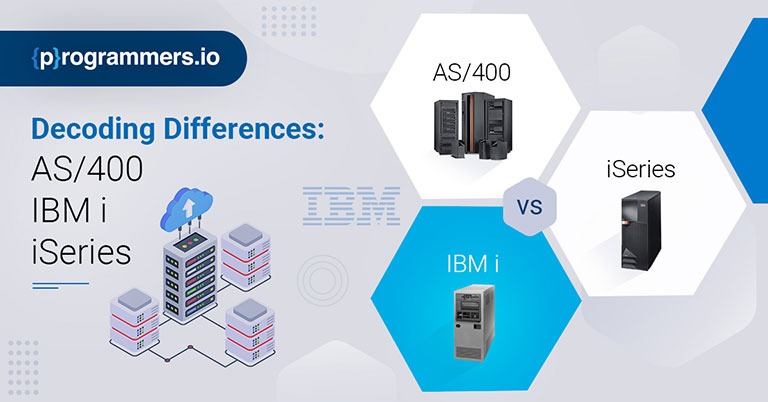Decoding Differences: AS400 vs. IBM i vs. iSeries
In enterprise computing, the landscape is rich with technologies that have evolved over the years. Among these, AS400, IBM i, and iSeries have been integral to the operations of many businesses. However, understanding their differences can be crucial in making informed decisions about the technology that best suits an organization’s needs. Let’s decode the differences between AS400, IBM i, and iSeries systems.
AS400 Software: A Legacy of Innovation
AS400, short for Application System/400, is a line of midrange computers introduced by IBM in 1988. AS400 has a rich history and has been a stalwart in the computing world for decades. One of the defining features of AS400 is its integration of hardware, operating system, database, and applications into a single cohesive unit.
What is AS400 Software Used For?
AS400 software is versatile and used for a myriad of purposes. It is a comprehensive platform for running business applications, managing databases, and facilitating seamless integration across various business processes. Its robust architecture has made it a preferred choice for those wanting a unified solution for their computing needs.
AS400 software also plays a pivotal role in streamlining operations and enhancing productivity. Its inherent capabilities extend to supporting critical business functions such as financial management, supply chain logistics, and customer relationship management.
The versatility of AS400 makes it an indispensable tool for organizations seeking a unified and efficient computing environment. Its robust architecture ensures reliability and scalability, allowing businesses to adapt to evolving technological landscapes while maintaining a stable and secure computing infrastructure.
Power10 IBM i: Unleashing the Power of Integration
Power10 IBM i, often just IBM i, is an evolution of the AS400 technology. IBM i represents a suite of enterprise-class systems that combine the power of IBM’s Power Systems servers and the flexibility of the IBMi operating system. This evolution marked a shift from the traditional AS400 branding.
AS400 vs. IBMi: Evolution in Terminology
While the shift from AS400 to IBM i brought advancements in technology and capabilities, it’s important to note that the essence remains the same. IBM i is an upgraded version of the AS400 operating system, inheriting and expanding its capabilities. The transition in terminology reflects the continual evolution and improvement in the capabilities of these systems.
With each upgrade, the system retains the robust features that businesses rely on and introduces new features to satisfy the evolving needs of the digital era. The enduring relevance of these systems demonstrates they can stand the test of time to provide a foundation for businesses to thrive in an ever-changing technological landscape.
iSeries Systems: Navigating the Branding Landscape
In the realm of IBM’s midrange servers, the term iSeries has also been a significant player. The iSeries represents a line of servers encompassing AS400 and IBM i technologies. Understanding the iSeries involves recognizing its role as a family name that covers a spectrum of systems, including those based on AS400 architecture and the more modern IBM i.
AS400 vs. iSeries: A Matter of Terminology
The relationship between AS400 and iSeries can be likened to that of a predecessor and a contemporary umbrella term. AS400 represents the historical foundation, while iSeries encapsulates a broader range of systems, including those with the modern IBM i operating system. The terminology shift reflects IBM’s commitment to evolving technologies and providing businesses with cutting-edge solutions.
iSeries, as a contemporary term, acknowledges the expanded scope beyond the traditional AS400 architecture. It signifies a holistic approach to encompass diverse computing environments under one umbrella, catering to the changing demands of businesses. Modernizing AS400 iSeries means embracing a continuum of innovation, where the rich legacy of IBM i/AS400 seamlessly integrates with modern computing advancements, ensuring businesses have a robust and adaptable platform for their varied needs.
Decoding the Differences
1. Hardware and Architecture:
- AS400: Historically associated with proprietary hardware architecture.
- IBM i: Evolution that retained compatibility with older AS400 hardware while introducing support for newer hardware architectures.
2. Operating System:
- AS400: Refers to the original operating system.
- IBM i: Represents the modernized and evolved operating system.
3. Terminology:
- AS400: The legacy term is often used interchangeably with IBM i.
- IBM i: The contemporary term reflecting the evolution of AS400 technology.
4. Integration and Compatibility:
- AS400: May need more compatibility with certain modern technologies.
- IBM i: Designed for seamless integration with contemporary technologies, offering enhanced compatibility.
5. Branding Landscape:
- iSeries: A family name covering a range of systems, including those with AS400 and IBM i technologies.
Choosing the Right System for Your Business
Deciding between AS400, IBM i, or iSeries systems depends on various factors, including the existing infrastructure, business needs, and future scalability requirements. For businesses heavily invested in AS400, transitioning to IBM i might be a strategic move, ensuring compatibility with modern technologies.
At Programmers.io, we specialize in navigating the intricate landscape of enterprise systems. Whether you want to enhance your existing AS400 infrastructure or transition to IBMi for improved capabilities, our experts are ready to assist you. Make informed decisions about your technology stack, embrace the power of IBM i/AS400 Development, and unlock new possibilities for your business. Connect with us today to embark on a journey of technological evolution.
How can we help you?
We have hundreds of highly-qualified, experienced experts working in 70+ technologies.









